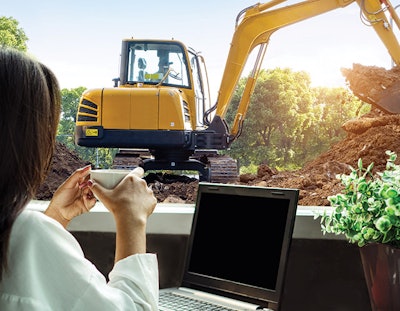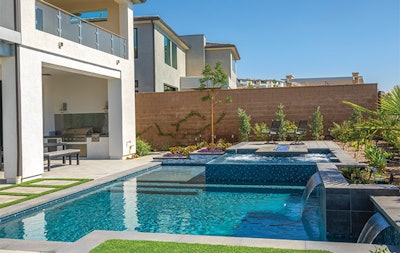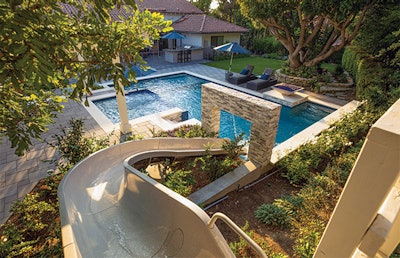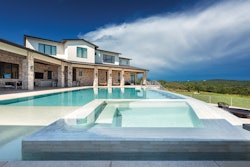
In This Article
|
It's an odd time. It's been about 10 months since the world suddenly became somewhat alien, and we have a few more months to go before things slowly start returning to something much closer to what we used to call "normal."
Of course, we can never go back. We will never return to that pre-COVID world of 2019, but we will move some distance back toward it when the vaccine becomes widely available. Public spaces will fill again like a drained pool being topped back up, and the current scorching demand for backyard products will become more manageable, because people will have options other than staying home.
We at AQUA believe that demand will remain somewhat elevated because the visceral pain and lessons of COVID will take a generation to fade. But we'll see.
For the moment, however, we're still in the outlandish land of COVID and will be for some months. We've been here long enough to get over the initial shock, adjust a bit and learn some things about how this odd planet works.
In general, for pool builders now, it's harder to get things, and it's harder to get things done.
Pre-COVID, a builder could order the pool equipment when the project was done because it would show up promptly at the jobsite, and you could install it. Now you can't because it won't.
Now you have to think ahead because calculating lead times for supplies is a whole new adventure, and you have to get creative to solve problems that you simply didn't have before. Not to this extent, anyway.
A lively description of the current dilemma was provided by a couple of builders at the PSP Expo's Builder Power Panel in November — Charlie Claffey, president of Claffey Pools in Southlake, Texas, and Scott Cohen, president of The Green Scene Landscaping and Swimming Pools, Chatsworth, Calif.
If you missed that, some highlights are provided here.
Claffey starts things off with a Texas-sized understatement, "I've never seen a year like this.
"It truly has been a wild year. At the beginning of the pandemic, there was a short period of time that we didn't know if we'd have a business. And then demand exploded.
"It was all we could do to stay up with it. To this point, that demand has not slowed. However, it has created a chaotic building environment in many different ways."
 Built during COVID by The Green Scene, this contemporary clean line design was given the nickname, "Flatten the Curve." (Image courtesy of GreenSceneLandscape.com by Irvin Pacheco)
Built during COVID by The Green Scene, this contemporary clean line design was given the nickname, "Flatten the Curve." (Image courtesy of GreenSceneLandscape.com by Irvin Pacheco)
Supply Problems: Raw Materials Are A Challenge Now
For many years, the price and availability of materials like cement, lumber, pool equipment, etc. have been a given. No longer. Lumber in much of the U.S. and Canada has been in short supply, and California saw a real shortage of cement this summer in part due to the disruptions from wildfires but mostly because one of the large plants was permanently shut down. That loss of supply has caused disorder in building schedules, which costs time, which costs money.
At the same time, plastics, the raw material of pool equipment, became a bottleneck for manufacturers as COVID interrupted and raised rates for shipping worldwide. This made it difficult to meet demand for standard pool equipment, a job which heretofore had been a straightforward process.
RELATED: The Best Year in History
"It's been very frustrating," says Cohen. "We used to get done with the job before ordering equipment because we knew we'd get it in three days. Well, that's no longer the case.
"We order the pool equipment before we even start the dig. Before we even have any place to put it. That's a new problem — storing equipment — so we're not waiting for it.
"And some of the sets are now a bit like Frankenstein. We have a part from here, a part from there. Above all, we don't want to keep the customer waiting. So we've got one company's feeder and one company's lights, and we're stealing equipment from another jobsite to finish.
"The biggest problem in California has been a shortage of cement. With no cement, there's no shotcrete."
"We've had to look at every project we have and try to buy materials in advance and stockpile, so we'll have enough to finish," says Claffey. "You have to pre-purchase now, and really understand what your costs are in order to protect the price you gave a customer for a pool you'll do six months from now."
With the flow of basic materials subject to interruption and delay, artful logistical planning has become a crucial skill for builders, as job costing and completion dates have become subject to forces outside company control.
 This backyard haven, built by The Green Scene, helps to make life fun despite the restrictions of COVID. (Image courtesy of GreenSceneLandscape.com by Irvin Pacheco)
This backyard haven, built by The Green Scene, helps to make life fun despite the restrictions of COVID. (Image courtesy of GreenSceneLandscape.com by Irvin Pacheco)
The Situation is in the Backyard: Customers Are A Challenge Now
One aspect of the COVID building environment that has been particularly challenging and at times unnerving is the homebound customer. In the good old days 10 months ago, the homeowner was usually busy elsewhere, at the office perhaps, or the gym or down at the marina — anywhere else but staring at the work crew through the back patio slider.
With everyone at home, scrutiny has been tight. And let's face it, nobody likes someone watching over their shoulder.
"Right now everyone is sitting at home with some time to watch out the window, so the spotlights are on you like they have never been before," says Cohen. "When we have a customer working from home, I'm extra sensitive because I know they're going to be calling saying, 'Hey, your guys were seven minutes late showing up today, and they took an extra two minutes on their break.' We're dealing with that from all of our customers."
With crews basically under surveillance, it's important to give customers something to watch. If there's nothing to watch — if customers get the feeling work is not moving forward — they can become aggressive. Cohen tries to maintain the impression of forward momentum.
"In any project, there's a certain sequence of events to get from the start to the finish line. We've tried to be creative in our sequencing to make sure there's always something happening back there.
"Regular emails to customers with videos and photos help us with that. Along the bottom of the email we have a "Project Tracker," and it changes with each email. It moves forward from step to step. We put cameras on all our jobsites so the office can keep track of things, too, so when the customer calls, we can look at the camera feed and tell them on the spot exactly what is happening in the backyard.
RELATED: A Deep Breath, Then on to 2021
"With everyone watching now, effective communication is more important than ever. Customers have an unquenchable thirst for communication. When they order a pizza, they're getting a text when it's going in the oven, when the driver is leaving and when the driver has arrived. They think with a bigger project like a pool, we ought to provide the same level of communication."
Claffey is seeing the same thing in Texas. "In this environment, silence between you and your customer is your worst enemy. And honesty and transparency are more important than ever," he says.
"You need to keep customers onboard with the plan. They don't understand the appearance of inactivity in the midst of construction. They're home pretty much all the time, so doing something in the backyard is important."
Keeping Subcontractors Is A Challenge Now
At a time like this, skilled labor is at a premium. That's been true for years, but now, it's even more true. Which means, more than ever, with schedule disruptions, crews waiting for supplies or an upstream phase of the project to be completed — and just the pressure of an enormous backlog of projects — the importance of keeping subcontracting crews loyal and focused on your projects has grown.
How to do that? Little things can mean a lot at a time like this, such as simple trust born of prompt payment, communication and appreciation.
"A sub's greatest fear is they won't be paid," says Cohen. His company assuages that fear and builds confidence by always paying within three days of invoice, establishing a sense of dependability that is the foundation of trust. "They will turn down work from other companies if they know you pay fast."
"They're just as important to the organization as your own people," adds Claffey. "This year, certain phases of construction are being impacted by lags in another part of the sequence. For instance, after digging a pool, we're waiting an unusual period of time to get the pool shot. And that puts stress on your masonry crews."
It's really important to keep an idled crew from wandering off to another company's project as it waits to proceed with work that's been delayed.
To avoid that, Claffey says, "We might have a masonry crew build something out of sequence to keep them busy while we're waiting for another part of the job to be done. We don't want to give them a reason to go elsewhere looking for work while we're waiting."
Pricing Is A Challenge Now
Basic economics asserts that if demand goes up, and supply stays the same, or even dips a little, prices will have to rise. This is not a guideline or a trend; it's referred to as a law of economics. And our industry obeys the law, mostly.
The demand for pools has skyrocketed, and with material shortages and all the funny little obstacles of COVID, supply has struggled. Prices for pools have had no choice but to follow the law and rise.
This being new territory, early on in the pandemic builders were tentative in their increases. Seeing those increases accepted without argument — perhaps a little too quickly — they raised prices some more.
RELATED: Taking Initiative In A Pandemic
But pricing in any business is always tricky. And it's tricky in COVID. You have the long term to think about: What happens when COVID is over? Will the world of pools go back to the way it was? Will demand immediately return to the levels of 2019? Will you look like a COVID profiteer when the vaccine renders the whole ordeal moot?
Builders have to balance all these factors now, and take into consideration the dramatic changes in raw material supply and the sometimes hidden problems COVID presents.
"You definitely don't want anyone feeling gouged," Cohen says, "but at the same time, we're seeing increases in costs of cement, lumber, and if you don't adjust your prices now, by the time you get to building those pools in your backlog, you're going to be losing money.
At the same time, we're unable to produce at the rate we used to. Our schedules require daily adjustment, which affects our cost. So you want to be very careful with pricing right now."
Managing Growth Now
At this unusual moment, meeting the demand for pools is like drinking from a firehose. It's tempting to try to suck it all in, but it's important to be thoughtful about the long-term effects of decisions made in the heat of the pandemic.
"You have to be careful not to take on too much," Cohen says, "because you can damage your reputation. When you're moving too fast, you start to get shaky, and you're making mistakes that you never used to make before. Those mistakes aren't being caught because people are trying to get the next job done because they're feeling the pressure to go faster. And those mistakes can cost you.
"One thing we do to manage growth is to schedule meetings with the client every two weeks, and so there's no way to take on too much work because we won't have time to meet with all the clients. And it keeps our eyes in the field."
RELATED: Success In Renovation
"The reality is you can only produce what you can produce," adds Claffey. "Our lead times are longer than they've ever been, and our clients have to understand that. We explain to each client: We're not going to just go find bodies to get this job done. We will build you a quality pool with skilled workers, but it will take time."
This kind of disciplined approach to your market and operations is more important than ever in the COVID crunch, which has caused havoc, plain and simple. Nearly all the forces of pool building are in flux — material supply, customer interaction, labor, demand and the time it takes to build a pool — all these crucial elements have become less predictable.
The COVID epoch will likely end this year, and one day, its pool building adventures will become the stuff of quaint and amusing legend. But for now, it's the reality.
This article first appeared in the January 2021 issue of AQUA Magazine — the top resource for retailers, builders and service pros in the pool and spa industry. Subscriptions to the print magazine are free to all industry professionals. Click here to subscribe.














































